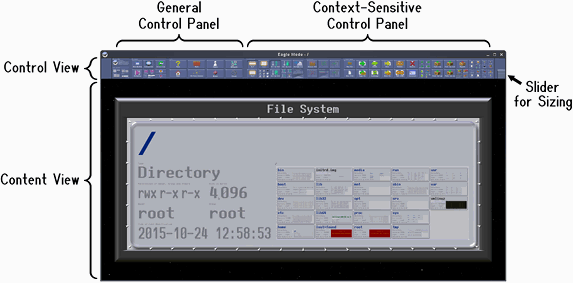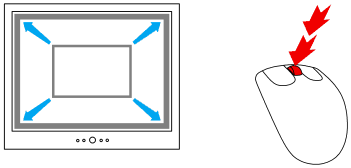 |
 |
| About |
| Videos |
| Screenshots |
| Documentation |
| Change Log |
| License |
| System Requirements |
| Install and Start |
| General User Guide |
| emFileMan User Guide |
| emFileMan Customization |
| Advanced Configuration |
| C++ API Tutorial |
| C++ API Reference |
| Make System |
| Download |
| Project Philosophy |
| Future Plans |
| Forum |
| Contact |
|
Hosted at:
Copyright © 2008-2025 Oliver Hamann. All rights reserved. All trademarks are the property of their respective owners. |
General User Guide
Copyright © 2008,2010-2011,2014,2016 Oliver Hamann. Homepage: http://eaglemode.sourceforge.net/
Contents
1 Introduction1.1 Windows, views and panels
1.2 Content view and control view
1.3 Popup-zoom
2 Mouse control
2.1 Zooming by mouse wheel
2.2 Zooming by mouse movement
2.3 Scrolling by mouse movement
2.4 Showing a panel full-sized, by mouse
3 Keyboard control
3.1 Keyboard focus
3.2 General keyboard functions
3.3 About hotkeys
4 Finding more help
5 When Eagle Mode hangs
1 Introduction
Eagle Mode is a zoomable user interface with many plugin applications. This documents describes its general usage and gives hints where to find further help.1.1 Windows, views and panels
In Eagle Mode, the user interface is made of windows, views and panels. A window is such a thing on the desktop that has a title bar, a border and a content area. The content area of a window is made of one or more views. Such a view shows something like a two-dimensional virtual world which can be zoomed and scrolled. That "world" consists of panels. A panel can be a simple thing like a button or an input field, or it can be a more complex thing like a group or a plugin application. Each panel can have child panels which are making up more details. This relationship of parents and children is also called a tree of panels. Thus, each view shows a tree of panels.1.2 Content view and control view
The main window of Eagle Mode has two views: a large content view at the bottom and a small control view at the top. The content view is for the things you are working on, and the control view is for commands, status information, settings and similar things. One could say the control view is a replacement for classic menu bars, tool bars and status bars. It has the popup-zoom feature (described more below).

There is a slider for sizing the control view. You can drag it up and down with the left mouse button. A double click on it minimizes or unminimizes the control view.
The control view itself is divided into two parts. On the left is a general control panel which always stays the same. And on the right is a context-sensitive control panel. This means, the right control panel depends on what is activated (focused) in the content view. Just navigate around in the content view and see how the right part of the control view changes. Note that some content panels do not provide any control panel, and so they leave the right side of the control view empty.
1.3 Popup-zoom
Some views have the popup-zoom feature. It means that when you zoom in, the view pops up and gets larger so that it is clipped by the screen bounds only. This makes small views much more comfortable, but it is suitable only for certain views like the control view and dialog windows.Similar to a classic popup menu, a popup-zoomed view automatically pops down when you click outside, or when you trigger a button in it. Not all buttons have that effect, but most of them. If you want to trigger a button without popping the view down, hold the Shift key while triggering the button.
2 Mouse control
This chapter describes how you can navigate through the panels of a view, using the mouse.2.1 Zooming by mouse wheel
For zooming in, move the mouse pointer to the location where you want to zoom in, and then push the mouse wheel upwards. For zooming out, push the wheel downwards.

Tips:
- For a slower zooming, hold the Shift key or the middle mouse button while pushing the wheel.
- By zooming in and out with different mouse positions, you can simulate a scrolling.
- If you want to zoom into a panel which is, for example, on the right side of the view, then you should position the mouse pointer near the right edge of that panel. Thereby, and with some practice, you can get the panel somewhat centered when you zoom in.
2.2 Zooming by mouse movement
For zooming by mouse movement, press and hold the Ctrl key and the middle mouse button, and move the mouse vertically. (With most mice, wheel and middle button are the same unit)

Tips:
- The initial mouse position is like with zooming by wheel.
- Hold the Shift key for a slower zooming.
2.3 Scrolling by mouse movement
For scrolling, press and hold the middle mouse button, and move the mouse into the desired scroll direction.

Tips:
- Hold the Shift key for a slower scrolling.
- After scrolling (or zooming) with the mouse, a "magnetism" may get active, which scrolls and zooms automatically to show the nearest panel full-sized. You can prohibit that magnetism by holding the mouse still for about one second before releasing the middle mouse button.
- The preferences provide an option for reversing the direction of scrolling in relation to the direction of moving the mouse. (The preferences are in the general control panel near the upper left corner of the Eagle Mode window)
2.4 Showing a panel full-sized, by mouse
For showing a panel full-sized so that it fits into the view, double-click with the middle mouse button on the panel. And for showing a panel full-sized so that the view is completely utilized, triple-click or shift-double-click with the middle mouse button on the panel.With some panel types, this function depends on the size and layout of the panel contents. Then it is a good idea to repeat the function after the panel has loaded or changed.

3 Keyboard control
3.1 Keyboard focus
There is always at most one panel on the screen which has the (keyboard) focus. Any keyboard input goes to that focused panel. The focus is shown by small arrows which surround the panel and point to it. There are several ways to move the focus to another panel. One is to zoom into the desired panel, another is to click with the mouse on it. Further ways are described more below.Views and windows can also be focused: The focused panel is always in the focused view, and the focused view is always in the focused window.
The focused panel is even called the active panel of a view. It remains active even when the view and the panel are losing the focus. In that state, the active panel is still indicated by arrows, but more pale. As soon as the view is focused again, its active panel is automatically focused too.
3.2 General keyboard functions
The following table describes the keyboard functions for zooming and scrolling, as well as for moving the focus.
| Key | Effect |
| Alt+Cursor-Key | Scroll into the desired direction. |
| Shift+Alt+Cursor-Key | Slowly scroll into the desired direction. |
| Alt+Page-Up/Down | Zoom in or out. |
| Shift+Alt+Page-Up/Down | Slowly zoom in or out. |
| Alt+Home | Show the focused panel full-sized so that it fits into the view. |
| Shift+Alt+Home | Show the focused panel full-sized so that the view is completely utilized. |
| Cursor-Key | Move focus to a sister panel in the desired direction. |
| Page-Up | Move focus to first child panel (but if there is no child, the panel is shown full-sized instead). |
| Page-Down | Move focus to parent panel. |
| Tab or Shift+Tab | Move focus to next or previous panel. |
| Home or End | Move focus to first or last panel. |
| Escape | Switch focus between content view and control view, and pop the control view up or down, respectively. This function is useful especially when having the control view minimized by the slider. |
3.3 About hotkeys
Many buttons of the control panels can be triggered by entering hotkeys. They are documented in the button descriptions - just zoom into the buttons to see those descriptions.
Important to know is that the hotkeys are functioning only when a panel in the content view is focused. For technical reasons they are not functioning when something in the control view is focused.
4 Finding more help
Many help texts can be found directly in the panels they are describing - just zoom in! Toolkit panels like buttons, input fields and groups often have a description right below their caption. In addition, interactive toolkit panels like buttons and input fields have general help texts ("How to use this panel") very small in the center of the left edge of the border. For example, a text input field describes all its functions there.The file manager is described in another document: emFileMan User Guide
The games SilChess, emMines, and emNetwalk are showing help texts in their control panels.
5 When Eagle Mode hangs
Sometimes Eagle Mode may hang for a short time. This could happen when zooming into a slow medium like a floppy disk, or when zooming into a disk that has to be woken up from a sleep state. Another reason could be that the operating system is busy in executing disk write operations which have been cached some time before.If it actually happens that Eagle Mode hangs and you feel that it does not respond to input, do not give wild input. Just wait - Eagle Mode will respond to the last input as soon as it gets active again.
If you think Eagle Mode hangs forever and you are in a fullscreen mode and you don't know how to come out, then you could try the following key combinations in that order: Alt+F4 (close window), Alt+Tab (switch to another window), Ctrl+Alt+Backspace twice (kill the X-Server and all windows), Ctrl+Alt+Del (soft reset or reboot - kills everything). If all that does not help, you may have to hard reset the computer, but note that this could mean some damage to the file system (don't do it before there is no disk activity for a long time).
|
Next Reading: emFileMan User Guide |